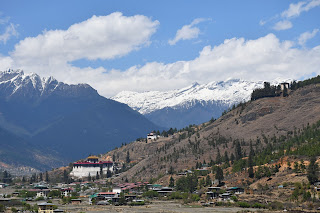Bhutan – Day 8: Paro Tshechu
It has been our luck this entire trip that upon leaving a place, the weather there always turns nice. Sometimes, however, the sun also shines on our destination. Such was the case today, when good weather accompanied much of our bus ride from Phobjikha Valley to Paro.
On our way, we saw
some new sights but eventually returned to familiar sceneries. Driving up and
down all morning, the highest point we reached was Lawala Pass at 3250 metres
above sea level. Soon, we found ourselves looking down at Wangdue Phodrang
Dzong and the village of Rinchengang, which we saw perhaps a lifetime ago (or,
in reality, four days previously). The rest of the journey seemed like a
homecoming: we took a coffee break at Dochula Pass, sped past the footbridge of
Tachogang Lhakhang, and stopped at a viewpoint across from Paro Dzong, a
building I had spotted from the plane’s window when we first landed.
We made a small picnic
on the grounds of Paro Dzong, after which we briefly toured the fortress. The
main reason for our visit, however, was Paro Tshechu, a five-day festival
celebrating the birth of Padmasambhava. The celebrations centre on mask dances,
which take place in a courtyard above the Dzong and always attract multitudes
of people dressed in their Sunday best. The dances are all allegories: we
arrived during the Dance of the Lord of Death, which symbolises the divine struggle
over one’s soul after death, and we departed after Drametse Ngachham, which
dramatises the main obstacles a Buddhist must overcome on their path to
spiritual fulfilment. It is said these dances were revealed to the terton Pema
Lingpa, which would make them 500 years old.






















































Comments
Post a Comment